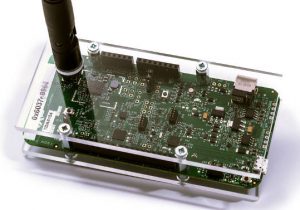
News
Modified Bluetooth could localise to 30cm

Needing only a standard Bluetooth transciever at each end of the link – so applicable to existing phones – adoption could lead to improved positioning, localisation and security.
“Today’s localisation solutions merely use signal strength that limits accuracy to 3-5m,” said Imec. “Until now accurate localisation and high security could only be achieved by using high-end solutions based on ultra-wideband [UWB] radios.”
The lab’s ranging technique uses phase-difference-on-arrival, and has been demonstrated on existing evaluation boards (see photo) for Bluetooth and IEEE802.15.4 chips, needing less than 32kbyte ROM and 64kbyte of RAM on an Arm Cortex-M4F and taking under 50ms per measurement running at 120MHz.
“It is extremely robust for multi-path reflections, which are typically a challenge for RSSI based solutions operating in indoor environments,” said Imec.
Protection against spoofing is included, by creating a secure channel between two authenticated devices.
“Location spoofing is an underestimated problem, that has moved from an academic research topic to a realistic threat in the field,” said Bart Preneel, head of COSIC, an Imec lab at Leuven university. “Fortunately, our early research in this area is paying off: in collaboration with Imec it has resulted in practical solutions.” – COSIC collaborated with Imec researchers at the Eindhoven-based Holst Centre in the project.
As an example of spoofing, Imec researcher Kathleen Philips described the use of covert signal amplifiers to vastly increase the range at which the phone in someone’s pocket could be made to unlock their Bluetooth-based car entry system – spoofing which could be defeated by adding a range qualifier.
“Together with our industrial partners, we are working on bringing this technology into a next version of the Bluetooth standard,” said Philips.
Applications are foreseen in building access and car entry as well as location-based data access services where accuracy and privacy are important, such as in hospitals where a patient’s record could appear automatically as the doctor approaches the patient’s bed.
Even without Bluetooth adoption, the technology can be used anywhere two IEEE802.15.4 transceivers are communicating. It is being development to meet Imec partner applications, and is available for commercial licensing. It is also applicable to ZigBee and Wi-Fi transceivers.